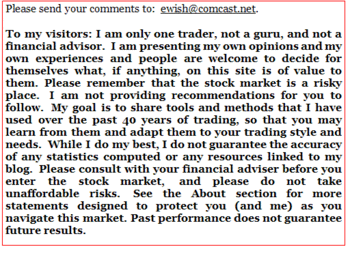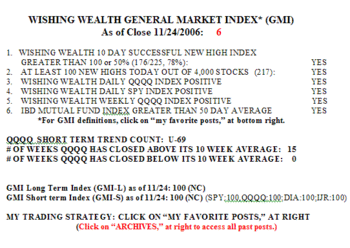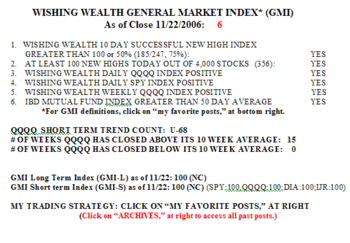The GMI fell one, to 5 and the GMI-S fell to 50, down 50. 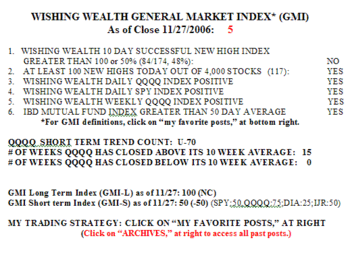 My short term indicators for all four indexes, especially the DIA, weakened Monday. Still, there were 117 new highs in my universe of 4,000 stocks. But only 6% of the Nasdaq 100 and S&P 500 stocks advanced on Monday, along with 10% of the Dow 30 stocks. The last time we saw single digit advances in these three indexes was last June 5 (6%, 5%, 3%, respectively) , in the early stages of the decline that ended on July 18. Monday was the 70th day in the current QQQQ up-trend, which remains intact.
My short term indicators for all four indexes, especially the DIA, weakened Monday. Still, there were 117 new highs in my universe of 4,000 stocks. But only 6% of the Nasdaq 100 and S&P 500 stocks advanced on Monday, along with 10% of the Dow 30 stocks. The last time we saw single digit advances in these three indexes was last June 5 (6%, 5%, 3%, respectively) , in the early stages of the decline that ended on July 18. Monday was the 70th day in the current QQQQ up-trend, which remains intact.
The IBD 100 stocks have not done much better than the Nasdaq 100 stocks recently.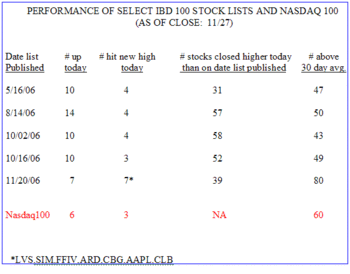 Only 7-14% of the IBD 100 stocks in the five lists that I have been following advanced on Monday, compared with 6% of the Nasdaq 100 stocks. But only 39% of the IBD 100 stocks from 11/20 closed higher than they did on the day the list was published. Still, 80% of those stocks closed above their 30 day averages, better than the 60% of Nasdaq 100 stocks that did so. Note how few stocks in these lists hit new yearly highs on Monday. Growth stocks have stalled for now.
Only 7-14% of the IBD 100 stocks in the five lists that I have been following advanced on Monday, compared with 6% of the Nasdaq 100 stocks. But only 39% of the IBD 100 stocks from 11/20 closed higher than they did on the day the list was published. Still, 80% of those stocks closed above their 30 day averages, better than the 60% of Nasdaq 100 stocks that did so. Note how few stocks in these lists hit new yearly highs on Monday. Growth stocks have stalled for now. 